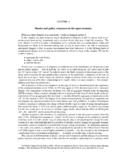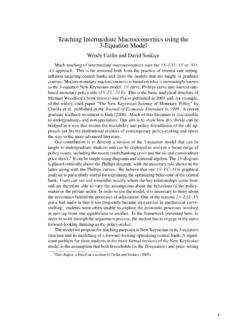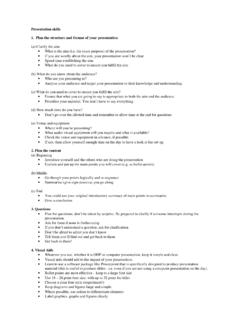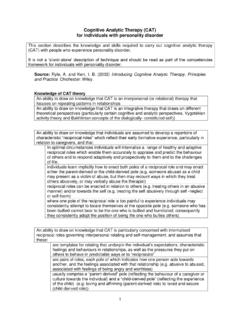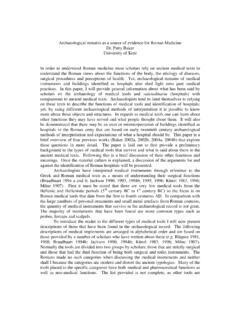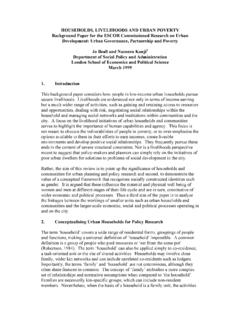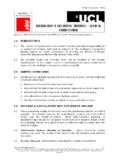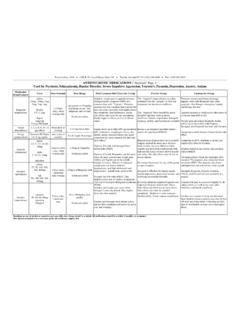Transcription of Assessment for CBT for psychosis - UCL
1 1 cbt for psychosis (CBTp) Knowledge of CBTp and its implementation An ability to draw on knowledge that CBTp is predicated on the development and realisation of a collaborative working relationship with the client, and that all activities associated with the intervention take place within this context An ability to draw on knowledge that in CBTp the central focus is on a maintenance model (the factors that drive and maintain distress and dysfunction), and that this concern with maintenance factors shapes both the Assessment and the intervention, and that: a primary aim of Assessment is to identify a maintenance model that helps to explain the individual client s distress and dysfunction maintenance models will usually include, and be supported by, a developmental formulation any decision about the timing, focus and content of interventions should follow from this maintenance model because each client s maintenance model will be different, the focus and content of a CBTp intervention can and should vary from person to person An ability to draw on knowledge that Assessment and formulation of each client s difficulties will determine the degree to which the maintenance model needs to focus on proximal and/or distal (developmental) maintaining factors An ability to draw on knowledge that because each client will have a different formulation the structure of CBTp interventions will differ from person to person, but an indicative order might be: Engaging the client, including a focus on.
2 Coping skills normalisation / validation of the client s experience affect regulation working with the client to identify the changes they would value and wish to work towards helping the client weigh the advantages and disadvantages of change instilling a sense of hope and optimism Graded work on symptoms, usually starting with verbal evaluation and introducing behavioural experiments in relation to the client s readiness to undertake them (or where the experiment is no lose and therefore unthreatening) Identification and evaluation of core beliefs regarding the self and others A focus on ending that includes: consideration of strategies for staying well (relapse prevention) consideration of, and support for, the client s social functioning, social support and social relationships consideration of, and support for, the client s understanding of themselves and their sense of empowerment An ability to draw on knowledge that the aims (and therefore the content) of therapy need to reflect the time available for the intervention This section describes the knowledge and skills required to carry out CBT for people with psychosis (CBTp) Effective delivery of CBTp depends on the integration of this competence list with the knowledge and skills set out in the CBT competence framework (accessed at: ).
3 2 An ability to draw on knowledge that because the content of CBTp reflects the client s current needs and concerns, the focus for clients who are in, or close to, an acute episode will be different to that for individuals who are between episodes ( where meaning-making may be more appropriate and relevant) An ability to draw on knowledge that in CBTp engagement, Assessment , formulation and intervention are best seen as iterative (rather than distinct) phases, and that: each area is likely to be revisited as contact proceeds therapists need to adopt a flexible (rather than linear) approach to each phase, tailored to client need and capacity the need for a thorough Assessment and formulation does not preclude the introduction of focused interventions that can promote engagement by helping the client experience early gains ( using no loss behavioural experiments to test-out ideas, or introducing specific techniques such as behavioural activation) An ability to draw on knowledge that the length of time needed to assess and formulate a client s difficulties can vary markedly, and will be influenced by factors such as.
4 Progress in building the therapeutic alliance the client s needs, capacities and concerns ( their ability to concentrate, their level of suspiciousness, and the complexity of their presentation) Knowledge about cognition and information processing An ability to draw on knowledge that clients may have difficulties in cognitive functioning ( in memory or attention) and/or intellectual functioning, and that: this may be relevant to their presentation and capacities can be accommodated by appropriate adjustments ( reducing cognitive demand by keeping to a short agenda, shorter but more frequent sessions, or flexibility over location) An ability to draw on knowledge of the information processing biases and distortions which are commonly observed in cognitive therapy, as well as those biases which may be relevant to the formation of delusional beliefs : selective abstraction (focusing on negative details taken out of context, ignoring other salient features, and drawing conclusions on the basis of this fragment of experience) jumping to conclusions data gathering bias (a tendency to draw conclusions which are not warranted from available information) belief inflexibility (the extent to which an individual can consider alternative positions or alternative hypotheses) ENGAGEMENT Ability to engage the client and build a collaborative approach to Assessment An ability to orient the client to the Assessment process (and to respond to their concerns or queries) by conveying the fact that the Assessment will usually.
5 Be wide-ranging ( focusing on the past as well as the present) include detailed consideration of their specific experiences ( hallucinations, delusional beliefs) be conducted over an extended period of time (rather than in one or two initial sessions) An ability to check with the client that the content and scope of Assessment conforms to their expectations, and to their needs 3 An ability to convey the importance of undertaking a careful Assessment before attempting to initiate change an ability to introduce discrete elements of CBT technique during the Assessment if this is likely to foster engagement and give the client a direct experience of the CBT model) : validating or normalising the client s experiences introducing behavioural activation keeping a diary of voices An ability to foster a positive alliance with the client by (for example): explicitly encouraging the client to talk openly about their experiences and concerns maintaining a consistently empathic position being alert both to what the client says and what they convey nonverbally (through their tone of voice, behaviour and body language).
6 Showing that the client s comments are taken seriously, regardless of content ( taking a neutral stance in relation to the content of a delusional belief and collaboratively weighing evidence for and against this way of thinking (while explicitly acknowledging its reality for the client)) validating the client s experiences by helping to show how thoughts, emotions, and behaviours are understandable ( in the context of their past history) showing an understanding of how the client makes sense of their voice(s) and empathising with their reactions to the experience of hearing voice(s) making judicious use of humour ( to normalise a client s experience or to reduce tension) helping the client to maintain their focus by offering frequent summaries of pertinent themes Ability to respond when the client is suspicious of, or hostile towards, the therapist An ability to counter any negative beliefs or suspicions the client may have about the therapist by.
7 Trying to understand (rather than react to) suspicion or hostility by holding in mind a formulation that encompasses the client s likely interactions with the therapist and others making judicious use of self-disclosure (so as to help assuage concerns that could arise if the therapist is seen as distant, cool and hard to read ) demonstrating a capacity for patience and persistence if the client presents as paranoid, hostile, reticent or incoherent ( by acknowledging that the client may be finding it challenging to be with the therapist but expressing a commitment to working with them) An ability for the therapist to be conscious of the impact of their nonverbal communications when a client presents as paranoid and/or aggressive ( taking care not to mirror a client s body language). An ability to anticipate the possibility that voices may be commenting negatively on the therapist by discussing this openly with the client ( sometimes people say that their voices don t like people like me discussing them; is this the case for you?)
8 An ability to work collaboratively with the client to develop strategies to manage if voices make it hard to proceed with the session ( agreeing with the client that they can stop discussion of the voices whenever they wish) 4 Ability to personalise and adapt session content to the individual client An ability to draw on knowledge of ways in which clients for whom normalisation is appropriate can be helped to normalise their psychotic experiences and beliefs ( to see them as being on a continuum with the experiences and beliefs found in the general population), for example, by: discussing the prevalence with which people in the general population hear voices introducing the concept of a continuum of experience with the general population noting that the attribution biases that can lead to delusional beliefs do not differ from those used by most people (it is the way that they are applied that can be different) An ability to be alert to factors that will influence the client s receptiveness to an Assessment and continued therapy, including.
9 Their mental state ( experiencing psychotic symptoms in the session) past experiences of services ( unhappy at yet another Assessment ) their expectations regarding being believed and/or criticised by the clinician their beliefs about their diagnosis and mental illness their attitude toward therapy An ability to tailor the ways in which information is conveyed to the client s needs ( aiding retention by using written information for the client to take away and/or making recordings of the therapy session for them to listen to at a later time). An ability to work collaboratively with the client to set an agenda for sessions that is efficient and appropriately flexible ( responsive to the client s state of mind and capacities) Ability to help the client experience shared control of session content An ability to maintain a collaborative and flexible approach to the Assessment , adapting its structure, content and length in relation to the client s capacity and needs An ability to check-in regularly with the client to determine: their sense of the helpfulness of what is being discussed their readiness to move on to new areas of discussion, or to try out new strategies their capacity to manage any emotional discomfort or difficulties that a new procedure may introduce An ability to help the client retain a sense of shared control by.
10 Being willing to stay with neutral topics of discussion ( those reflecting the client s personal interests or hobbies) where this shift of focus reflects the client s attempt to regulate emotional discomfort being willing to be flexible about the settings in which sessions take place finding a shared language and terminology congruent with the client s phraseology and understanding using a recovery oriented stance so as to maintain a focus on the client s goals, motivations and strengths An ability to change tack in response to high levels of distress, discomfort, or evidence of the unhelpfulness of a strategy. Ability to deal with the emotional content of sessions An ability to draw on knowledge of the importance of creating a safe environment within which the client can discuss and express their emotional reactions An ability to assess the client s capacity to focus on negative or painful emotions, (for example, by being guided by their capacity to acknowledge, label and manage emotions) 5 An ability to help the client regulate affect in the session, for example by.
